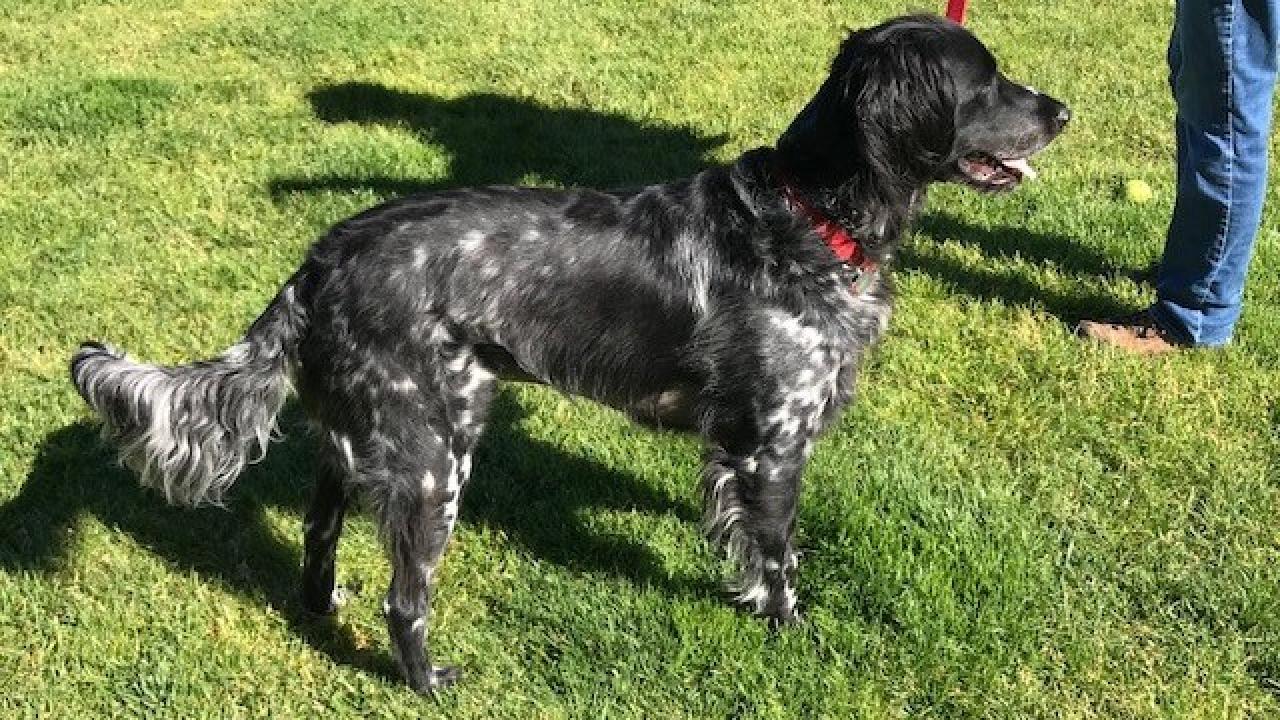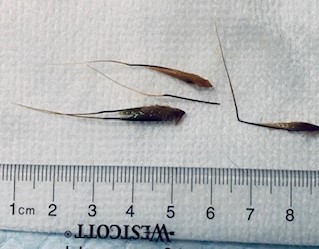
Continual Care Available Throughout COVID-19 Crisis Saves Dog’s Life
Max, a 4-year-old male Large Munsterlander, enjoys walks with his owners, Dr. Stevan Cavalier—a retired physician—and his wife Stephany near their home in the Bay Area. While they take precautions for their dogs due to the presence of foxtails in the area, it’s not always a guarantee that the dogs will stay completely away from the dangerous plants. Recently, Max had a decreased appetite, was lethargic, and had a fever and an increased respiratory rate. He was immediately taken to a local veterinary clinic.
Diagnostic tests revealed fluid buildup in Max’s chest cavity, consistent with a foreign body in the area.
“Naturally, we assumed a foxtail migration,” said Dr. Cavalier. “We were offered a CT scan and exploratory thoracotomy surgery (procedure to gain access into the chest) to be performed the next day – a frightening prospect to be sure.”
Hoping Max might qualify for a minimally invasive procedure, Dr. Cavalier asked Max’s veterinarian for a referral to the UC Davis veterinary hospital. After consultation with UC Davis to be certain the facility was capable of helping Max during the COVID-19 pandemic, plans were made to bring Max to Davis later that day.
Because of the pandemic, the UC Davis veterinary hospital transitioned to an “emergency only” basis on March 16, which included the continuation of critical care appointments such as chemotherapy and radiation treatments that were already in progress. (Starting May 13, the hospital began a phased re-opening of other services.) Clearly, Max’s life-threatening condition applied.
Foxtails—a type of seed cluster found in a small group of weed plants—are commonly found in Northern California, including foxtail grasses, barley and millets. While these weeds may seem harmless, animal owners should be vigilant to keep their pets away from plant awns. Covered with microscopic projections, foxtails can pose severe health risks to animals, as they migrate into tissue causing abscesses and widespread infections. The physical make-up of the foxtail stops it from reversing direction and exiting the body. The most common access points foxtails utilize to enter the body are through the nose, mouth and ears, but they can also penetrate the skin causing wounds and subcutaneous abscesses.
Once at UC Davis, Max was admitted to the Emergency Room via the hospital’s curbside check-in instituted during the pandemic crisis. There, he was treated by Dr. Jessica Jones, a staff veterinarian with the Emergency and Critical Care Service.
“Max received a thoughtful evaluation from Dr. Jones, who expeditiously contacted the attending resident and faculty veterinarians, as well as the on-call surgeon,” said Dr. Cavalier. “We were immediately impressed with the nuanced, sensible, and well-articulated thinking that Max encountered in the Emergency Room, and their prompt communication to us in the parking lot. We were advised that it was highly unlikely Max would qualify for a minimally invasive procedure.”
Max was transferred to the inpatient hospitalization ward, where third-year resident Dr. Tomaso Rosati assumed the primary role in his care.
“Dr. Rosati’s conversations were similarly thorough, unrushed and articulate, reflecting a blend of sophisticated medical expertise and common sense,” Dr. Cavalier appreciated. “He clearly explained the logic that informed his decision making, including consultation with the faculty critical care specialist and with Dr. Philipp Mayhew, the faculty surgeon enlisted in Max’s care.”
“It was clear that essential and detailed information was shared effectively among all these doctors,” said Dr. Cavalier. “Every update we received thereafter reflected effective and detailed intra-service hand-offs. As a retired physician, I know such internal communications are a key place where medical care often breaks down. As this wasn’t the case at UC Davis, that reflects a high level of commitment at the veterinary hospital to providing the highest quality of multi-specialty care for its patients while respecting the family’s need to be fully informed.”
“We experienced an unrushed, incredibly well-informed phone conversation with Dr. Mayhew, referencing his vast experience and research with canine foxtail migrations, leaving us feeling confident in Max’s care plan,” continued Dr. Cavalier.
The following day, Max was anesthetized for a CT scan to help pinpoint the location and severity of the foxtail migration. The scan revealed three foreign materials in the bronchial tree. Based on recent research by Dr. Mayhew and others of patients that present with a history of potential foxtail exposure, CT scans can miss the presence of foxtails in the airways of 25 percent of patients. Therefore, a bronchoscopy (camera scope of the lungs) is also routinely performed before moving on to an exploratory surgery.

Even though the CT scan caught the presence of three foxtails, there could be others, so Dr. Mayhew consulted with Dr. Craig Sutter, a resident with the Internal Medicine Service for him to go through with the bronchoscopy. Thankfully, the foxtails were in an area where the scope was able to identify and remove them from Max’s lungs, preventing invasive surgery.
“We are so grateful that we were offered a care path that spared Max immediate major surgery,” said Dr. Cavalier.
It is possible that Max may still have unrecovered foxtails in his system. In some cases, dogs are capable of breaking down the organic material by themselves and never have another problem. Max was sent home for a closely monitored round of antibiotics.
“We explained to Max’s owners that we felt confident about taking a more conservative course of action, which we are only able to do in about 10 percent of these cases,” explained Dr. Mayhew of the hospital's Soft Tissue Surgery Service. “Max’s owners know to be vigilant and monitor for further clinical signs over the next few months before we know he is out of the woods.”
“All of Max’s care, which included so many parts, transpired over a hospitalization of just 24 hours,” Dr. Cavalier said. “In addition, every provider delivered on promises to keep us well-informed all along the way. From the client service representatives—who always knew Max’s story and were always amazingly up to date on his current status—to his veterinarians to his technical support staff – every aspect of Max’s care was exceptional. We feel grateful to live as close as we do to the UC Davis veterinary hospital. We are especially grateful to the multi-disciplinary team who safely worked together during the pandemic—a time of shortages and fear—to give Max total devotion and lifesaving care.”
# # #
